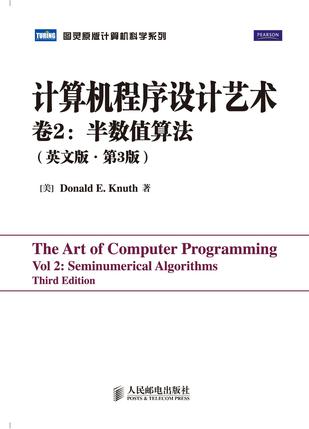计算机程序设计艺术(第2卷 英文版·第3版)

作者简介:
Donald E. Knuth,1938年1月10日出生于美国明尼苏达州的米尔沃基,著名计算机科学家,算法与程序设计技术的先驱,斯坦福大学计算机系荣誉退休教授,计算机排版系统TEX和 METAFONT字体系统的发明人,最年轻的图灵奖得主。他在计算机科学及数学领域出版和发表了多部具有广泛影响的著作和论文。 他获得了很多奖项和荣誉: 1971年获首届美国计算机协会(ACM) Grace Murray Hopper奖 1973年当选为美国科学艺术学院院士 1974年获美国计算机协会图灵奖 1975年当选为美国国家科学院院士,同年荣获美国数学协会(MAA)福特奖(Lester R. Ford Award) 1979年获卡特总统颁发的美国科学奖 1981年当选为美国工程院院士 1982年获计算机先锋奖(Computer Pioneer Award) 1982年成为IEEE荣誉会员 1986年荣获美国数学学会(AMS)斯蒂尔奖(Steele Award) 1988年获富兰克林奖章(Franklin Medal) 1994年获瑞典科学院Adelskold奖 1995年获IEEE冯·诺依曼奖 1996年获稻盛基金会京都奖(Kyoto Prize) Knuth的中文名字高德纳广为人知,这是1977年他访问中国之前由姚期智教授的夫人姚储枫所取。
内容简介:
《计算机程序设计艺术》系列著作对计算机领域产生了深远的影响。这一系列堪称一项浩大的工程,自1962年开始编写,计划出版7卷,目前已经出版了4卷。《美国科学家》杂志曾将这套书与爱因斯坦的《相对论》等书并列称为20世纪最重要的12本物理学著作。目前Knuth正将毕生精力投入到这部史诗性著作的撰写中。想了解本书最新信息,请访http://www-cs-faculty.stanford.edu/~knuth/taocp.html。
目录:
Chapter 3 Random Numbers 1 3.1. Introduction 1 3.2. Generating Uniform Random Numbers 10 3.2.1. The Linear Congruential Method 10 3.2.1.1. Choice of modulus 12 3.2.1.2. Choice of multiplier 16 3.2.1.3. Potency 23 3.2.2. Other Methods 26 3.3. Statistical Tests 41 3.3.1. General Test Procedures for Studying Random Data 42 3.3.2. Empirical Tests 61 *3.3.3. Theoretical Tests80 3.3.4. The Spectral Test 93 3.4. Other Types of Random Quantities 119 3.4.1. Numerical Distributions 119 3.4.2. Random Sampling and Shuffling 142 *3.5. What Is a Random Sequence? 149 3.6. Summary 184 Chapter 4 Arithmetic 194 4.1. Positional Number Systems 195 4.2. Floating Point Arithmetic 214 4.2.1. Single-Precision Calculations 214 4.2.2. Accuracy of Floating Point Arithmetic 229 *4.2.3. Double-Precision Calculations 246 4.2.4. Distribution of Floating Point Numbers 253 4.3. Multiple Precision Arithmetic 265 4.3.1. The Classical Algorithms 265 *4.3.2. Modular Arithmetic 284 *4.3.3. How Fast Can We Multiply? 294 4.4. Radix Conversion 319 4.5. Rational Arithmetic 330 4.5.1. Fractions 330 4.5.2. The Greatest Common Divisor 333 *4.5.3. Analysis of Euclid's Algorithm 356 4.5.4. Factoring into Primes 379 4.6. Polynomial Arithmetic 418 4.6.1. Division of Polynomials 420 *4.6.2. Factorization of Polynomials 439 4.6.3. Evaluation of Powers 461 4.6.4. Evaluation of Polynomials 485 *4.7. Manipulation of Power Series 525 Answers to Exercises 538 Appendix A--Tables of Numerical Quantities 726 1. Fundamental Constants (decimal) 726 2. Fundamental Constants (octal) 727 3. Harmonic Numbers, Bernoulli Numbers, Fibonacci Numbers 728 Appendix B--Index to Notations 730 Index and Glossary 735




评论